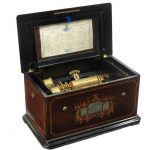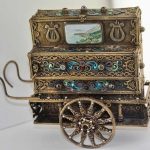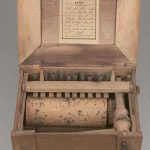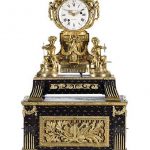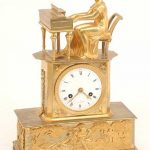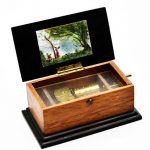The organ is a keyboard instrument of one or more pipe divisions or other means for producing tones, each played with its own keyboard, played either with the hands on a keyboard or with the feet using pedals. The organ is a relatively old musical instrument, dating from the time of Ctesibius of Alexandria (285–222 BC), who invented the water organ. It was played throughout the Ancient Greek and Ancient Roman world, particularly during races and games. During the early medieval period it spread from the Byzantine Empire, where it continued to be used in secular (non-religious) and imperial court music, to Western Europe, where it gradually assumed a prominent place in the liturgy of the Catholic Church. Subsequently it re-emerged as a secular and recital instrument in the Classical music tradition.
Music boxes tend to have a mechanical organ, an organ that is self-playing, rather than played by a musician. For example, the barrel organ is activated either by a person turning a crank, or by clockwork driven by weights or springs.
Usually, mechanical organs are pipe organs although some instruments were built using reeds similar to those found in a harmonium. Since the 1950s, some instruments have been built using electronics to generate the sound, though still operated by mechanical or pneumatic means.
Originally, the music for mechanical organs was stored by pins on a large barrel. Such instruments were called barrel organs. Such organs only have a very limited repertoire, both in the number of musical selections that could be stored, and the length of tune that could be accommodated. Reference: Wikipedia
A large and rare B. A. Bremmond organ cylinder musical box, Swiss, late 19th century, each of the eight 20cm cylinders playing 10 airs on 36 organ reeds as listed on tune sheet and indicated by pointer, the movement with long playing double spring barrels in rosewood veneered case, lid inlaid with pewter, sunburst and marquetry lyre, the front inlaid with marquetry coloured woods and pewter organ facade, together with two pine cases for cylinder storage, the music box case, 30in (76cm) wide
Sold for £ 5,000 inc. premium at Bonhams in 2014
A REGENCY GILT-BRASS MOUNTED MAHOGANY QUARTER-STRIKING MUSICAL ORGAN CLOCK THWAITES & REED, CLERKENWELL, LONDON, EARLY 19TH CENTURY The case with turntable base above a later mahogany, brass and gilt-wood mounted pedestal, with three pull stops to the right side for the organ pipes, the 12 in. painted dial signed ‘Thwaites & Reed / Clerkenwell / LONDRES’, with polychrome floral decoration and tune music selection (SONG / COOLUN / TYROLESE / WALTZ / WALTZ / WALTZ / WALTZ / WALTZ / CONTRADANZA / CO NTRADANZA) and REPITE / SILENCIO flanking the organ selector for ‘SILENT / PLAY EACH HOUR / PLAY’, the substantial triple chain and fusee movement with anchor escapement and striking the hours on a single bell and the quarters on a nest of eight bells, trip repeat, backplate signed ‘Thwaites & Reed / Clerkenwell / LONDON’, the substantial chain and fusee organ movement wound from the side and playing through 50 pipes via 12 in. long pinned wooden barrel; pendulum 93 in. (236.2 cm.) high; 30 ½ in. (7.4 cm.) wide; 26 in. (6 cm.) deep
Sold for GBP 20,000 at Christie’s in 2017
Antique enamel on sterling silver Swiss music box in the form of an Organ Grinder’s Cart.The enameled silver gilt is incrusted with semiprecious stones , pearls and a painted porcelain scene most likely of lake Geneva
Sold for $1,400 at Winston Auction Group NYC in 2019
Musical Clock with Musical Clock and Organ,ca. 1625 Veit Langenbucher German
Inside the ebony case of this musical clock is an extremely rare and important instrument consisting of a sixteen-note pipe organ and a sixteen-string spinet that may be played independently of the organ. Made by the renowned team of Samuel Bidermann and his son (also Samuel)–the father’s L-shaped pinning style appears in this work–and Viet Langenbucher, the extraordinary piece includes, in addition to the organ and spinet, a clock and five carved and colorfully clad commedia dell’arte figures that perform a circling dance in the clock’s tower when the instruments sound to mark the hours.
The complex clock is perhaps the most musically elaborate automatic instrument to survive from the early seventeenth century. Its three airs, probably by composer Hans Leo Hassler (baptized 1564-1612), the elder Bidermann’s teacher and once keeper of the knowledge of pinning barrels in Augsburg, are stored on the original pinned cylinder. Most cylinders and their tunes were replaced by subsequent generations, but this one was spared to provide us with an extremely rare musical document that allows us to hear the airs as they were played in the seventeenth century.
Reference: The Metropolitan Museum of Art
Bird organ (serinette) 19th century Object Place: France
Compass from c”’ to e””. Roughly made rectagular box of ash. Ten small organ pipes operated through a tracker mechanism by a large pin barrel with a spur gear. Small bellows inside the case. The inside mechanism is operated by a crank handle fixed to a combination worm and crank shaft. The worm engages the spur gear on the barrel and the crank operates the bellows. The barrel is mounted on a movable bracket which has on the right- hand side a projecting shift pin with eight notches. One of the notches is engaged by a latch, permitting the selection of one of the eight airs set on the barrel.
Reference: Museum of Fine Arts Boston
An attractive and important French Louis XVI ebonized and ormolu sculptural quarter striking mantel clock on music box, Glaesner A Lion, circa 1770 14-cm enamel dial with Roman numerals and outer five minute marking signed Glaesner A Lion, finely foliate pierced gilt and engraved hands flat bottomed movement with anchor escapement and silk suspended pendulum, countwheel quarter striking on two bells with connection to the double fusee and chain musical mechanism, 23-cm wooden cylinder playing one of eight airs on 17 metal organ pipes changing the airs automatically, ormolu case surmounted by an ornamental urn and with foliate scrolls to the sides, break front scolled support hung with garlands flanked by two putti personifying The Arts, shaped moulded base raised on an ormolu mounted plinth with gilt stars on an ebonized ground, similarly decorated music box with protruding ormolu capped fluted corner columns, ormolu mouldings and hinged cast pierced panels incorporating musical instruments and scrolling leaves, raised on flat feet height 89cm
Sold for 42,000 EUR at Sotheby’s in 2006
